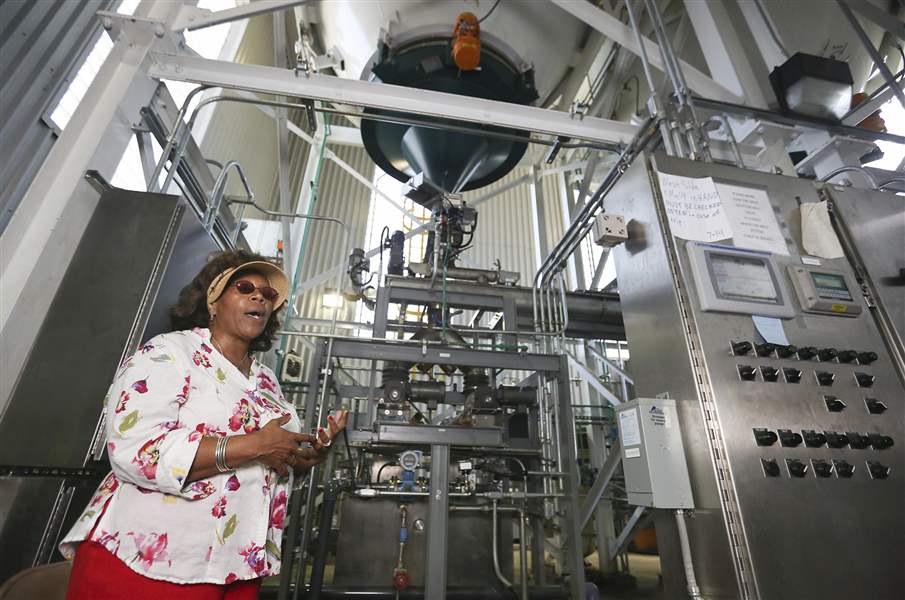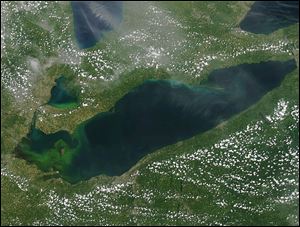
TOLEDO STILL ON ‘watch’ status
Algae toxin level drops slightly at lake intake
Taps safe, but officials on guard
7/29/2015
Toledo Mayor Paula Hicks-Hudson, visiting Toledo’s low service pumping station in Jerusalem Township, says several water samples were taken Tuesday at the water surface, below the surface, and at the intake crib to check for microcystin.
THE BLADE/DAVE ZAPOTOSKY
Buy This Image

Toledo Mayor Paula Hicks-Hudson, visiting Toledo’s low service pumping station in Jerusalem Township, says several water samples were taken Tuesday at the water surface, below the surface, and at the intake crib to check for microcystin.
The level of microcystin in Lake Erie where Toledo draws its drinking water dropped slightly Tuesday, but its presence was still enough for city chemists to stay on guard.
A small amount of microcystin was detected in the city’s Lake Erie intake crib — 0.4 parts per billion, down from 0.5 parts per billion Monday, city spokesman Stacy Weber said.
Ms. Weber announced the latest results just before 3 p.m. Tuesday but refused to release laboratory documentation confirming the microcystin level in the raw lake water or the city’s treated drinking water sent to 500,000 customers.
Mayor Paula Hicks-Hudson announced Monday that the algae-produced toxin, which can cause liver and kidney damage and resulted in a nearly three-day water crisis last August, had been detected in lake water but not in the treated tap water.
RELATED ARTICLE: Area shoppers stock up on water
DASHBOARD: Current status of Toledo’s water quality
Chemists for the city of Toledo, accompanied by the mayor, took raw water samples at the intake crib Tuesday morning.
Ms. Hicks-Hudson said several samples were taken at the water surface, at 10 feet below the surface, and directly at the intake crib.
The mayor emphasized again Tuesday that Toledo’s drinking water remains safe and microcystin was not detected this week inside the Collins Park Water Treatment Plant.
“I am even more determined now to get the state and federal government to help us,” Ms. Hicks-Hudson said, referring to the quality of the raw lake water.
Also Tuesday, the mayor inspected the city’s low service pump station in Jerusalem Township before the water samples were delivered to the Collins Park Treatment Plant for testing.
The toxin was first detected at about 2 p.m. Monday, when tests showed 0.3 and 0.4 parts per billion.
A later sample at 7 p.m. showed the level at 0.5 parts per billion.
The mayor told the public at 8:50 p.m. that she had raised the city’s water-quality status from “clear” to “watch.”
Water takes about 90 minutes to travel from the intake crib to the city’s low service pumping station, and then another four hours to travel to the Collins Park Water Treatment Plant. That 5½ hours is “more than enough time to treat the water,” Mayor Hicks-Hudson said.
Even with the slightly lower microcystin level in the water, the city’s water-quality dashboard remained unchanged, at “watch” status, for a second day. That’s the second step on the city’s five-step rating system.
If the city changed the status from “watch” to “caution,” that would mean microcystin has been detected in tap water but the level does not mandate an advisory.

A large algal bloom is seen Tuesday from a MODIS satellite image around the Lake Erie islands and Port Clinton.
The U.S. Environmental Protection Agency in May announced that people school-age and older can safely drink tap water with up to 1.6 parts per billion of microcystin in it.
The limit set this year for infants and children younger than 6 years old, pregnant women, nursing mothers, people with liver conditions, and those on dialysis, is 0.3 ppb.
The new guidelines set aside 1998 World Health Organization recommendations of 1.0 parts per billion that states had been using while awaiting U.S. EPA guidance.
The Ohio Environmental Protection Agency ordered the city to declare the crisis last summer once the toxin level in tap water went above 1.0 parts per billion.
It was found to be above 1.6 parts per billion, but not consistently.
Toledo-Lucas County Health Commissioner Dr. David Grossman said Tuesday he is confident the city water is safe
“The water is absolutely top-notch at your tap. In fact I drank it today,” he said at the news conference.
Dr. Grossman, Mayor Hicks-Hudson, and Chuck Campbell, the city’s commissioner of water treatment, called the news conference to assure the public that although small levels of microcystin have been detected in the lake near the intake site, processes have been put in place that cleaned out any harmful levels of contaminants before the water even reached the treatment plant.
“I can’t look into the crystal ball and predict what’s gonna happen but I know that we are prepared for it. We can feed more chemicals. We have enhanced our treatment process. We are prepared as we can be,” Mr. Campbell said.
He emphasized that no matter what, city water will not be shut off.
The health department will, however, issue advisories to the public when and if the levels coming out the tap are greater than 0.3 ppb, which can be harmful for children younger than 6 or high-risk groups if it is ingested for 10 days or more.
The other number that would trigger warnings from the health department is 1.6 parts per billion of microcystin in water coming out of the tap. If adults or anyone ingests the bacteria at that level for 10 days it could lead to illness, Dr. Grossman said.
“If it’s 1.6 at the tap tomorrow and you have a cup of coffee, you don’t need to run to the emergency room,” but drinking at that level at up to 10 days can do you real harm, he said.
Mycrocystin can cause stomach issues such as nausea, diarrhea, and vomiting. In rare cases it can cause liver failure or death if ingested in great amounts, Dr. Grossman said.

Unlike last year, it is very unlikely authorities will advise people not to take showers in the contaminated water because large amounts of microcystin are required to irritate the skin.
The health department may, however, advise restaurants to take extra steps to clean dishes if levels rise above 0.3 ppb, he said.
“Chlorine is appropriate, but not many of us at home have three-compartment sinks to clean dishes. I would say if you are going to clean them, wash it, then rinse it completely with tap water, then let it dry, and then rinse with bottled water,” Dr. Grossman said.
Despite the assurance from officials, area stores experienced a run on bottled water late Monday night after city leaders confirmed the microcystin levels in the lake had risen slightly.
“There is absolutely no need to panic right now and fill up your house with water,” Dr. Grossman said. He added, however, that it is always smart to have at least a four-day supply of drinking water in your home in case of emergencies.
Todd Audet, district deputy director for the Ohio Department of Transportation in Bowling Green, said his agency has moved substantial amounts of bottled water from the Ohio Air National Guard base at Toledo Express Airport to its Lucas County garage in Monclova Township so it is ready for distribution if needed.
“There won’t be any delay in having water available for the needy” if a crisis arises, Mr. Audet said, citing in particular the need to provide social-service agencies such as Meals on Wheels with backup supplies.
NASA satellite images published online by the National Oceanic and Atmospheric Administration show a thick algal bloom anchored across the middle of Lake Erie’s western basin between Toledo and Sandusky.
Blooms typically start in the most western part of the lake, near Toledo and Monroe, and move eastward. But the formation of algae and the progression of it is not always predictable.
It can shift within hours based on wind direction, wave action, and other factors.
Doug Wagner, superintendent of water for the city of Oregon, said tests Monday showed no microcystin in raw or treated water. He planned to run another series of tests today.
Kelly Frey, superintendent of the Port Clinton water-treatment system, said the current bloom has “been parked right over Port Clinton and Catawba Island” for days.
“It’s been concerning, that’s for sure,” Mr. Frey said. “We’re going to be in for a pretty interesting August and September.”
Raw lake water near the Port Clinton intake had 0.55 ppb of microcystin on Friday, rising to 1.7 ppb today, Mr. Frey said.
Blade staff writers Tom Henry and David Patch contributed to this report.
Contact Ignazio Messina at: imessina@theblade.com or 419-724-6171 or on Twitter @IgnazioMessina.